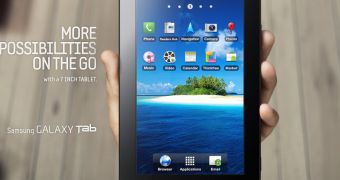Today, leading mobile phone maker Samsung Electronics announced officially the launch of its Samsung GALAXY Tab (GT-P1000) tablet PC, which is powered by Google's Android 2.2 operating system.
According to the company, the new GALAXY Tab is only the first device in its series of slates, as it plans on making great steps in the tablet PC market.
At the same time, Samsung announced that the new device is set to become available for purchase on the UK market in the following months.
“The Samsung GALAXY Tab brings together all of Samsung's leading innovations to provide users with more capabilities while on the move,” the company announced.
Among the specifications the new device comes to the market with, we can count a 7-inch TFT-LCD display, 3G HSUPA connectivity, 802.11n Wi-Fi, and Bluetooth 3.0 capabilities, all packed inside a rather light design at only 380g.
In addition to support for Adobe Flash Player 10.1 and appealing multimedia features, the new device also comes with support for various communication means, including e-mail, voice and video call, SMS/MMS or social networking.
“Samsung recognises the tremendous growth potential in this newly created market and we believe that the Samsung GALAXY Tab brings a unique and open proposition to market. There is a new and emerging consumer demand that Samsung can satisfy since mobile is in our DNA,” Simon Stanford, Head of Mobile, Samsung UK and Ireland.
“The Samsung GALAXY Tab has been designed to enable consumers to maximise their online experience wherever that may be. The Samsung GALAXY Tab is pushing the market in new directions and Samsung believes this is only the beginning of its innovations as pioneers in smart media devices.”
Samsung's unique e-reading application 'Readers Hub' was included on the slate, as well as its 'Media Hub' and 'Music Hub' solutions, offering access to films, videos and music. The slate is powered by a Cortex A8 1.0GHz application processor, and comes with support for HD video content like DivX, XviD, MPEG4, H.263, H.264 and more.
“While a front-facing camera allows for face-to-face video telephony over 3G, a rear-facing camera captures still images and video that you can edit, upload and share, all without any hassle,” the company concludes. More on it can be found here.

 14 DAY TRIAL //
14 DAY TRIAL //